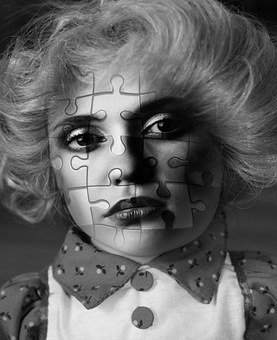
In February 2013, Joss Wheedon brought the idea of living, programmable human dolls to the screen in the popular television series, The Dollhouse. The series centered on the human “dolls” that could erase and reprogram their personalities and assume the qualities they would need to cater to the varying engagements for the wealthy, powerful and well connected to further their own ends.
Caricature masks to look like a woman, contacts to remove the irises, latex bodysuits, and an endless carousel of plastic surgery and YouTube makeup tips…
Welcome to the subculture of the Living Doll.
What Exactly is a Living Doll?

The Living Doll subculture consist of individuals who share the strange obsession with perfection, specifically in dolls, and spend enormous sums of money and time – sometimes enduring a continuous cosmetic surgery regimen - to live their lives as a plastic doll.
Becoming the perfect doll in this subculture can generally be achieved in one of two ways: either through the use of bodysuits, masks and makeup or, more drastically, undergoing an almost never ending cycle of plastic surgery in pursuit of becoming the perfect doll. In some more extreme cases, when the treadmill of plastic surgery is not enough, such as the case of Blondie Bennet, regular hypnotherapy is in order to achieve the vacant mind of a Barbie doll.
Masking
One of the more interesting sets of the Living Doll subculture is the Masker. In this set, men wedge themselves into what is termed FemSkin: a form fitting, silicone bodysuit. The men will then don a caricatured feminine mask in an effort to embody their ideal fantasy woman.
”Maskers, by definition, are experts at obscuring their identities. But it’s not just in the silicone and latex masks that they achieve this, many of the men involved in this subculture hide the very fact of their masking from employers, friends and family.”
While there is no common underlying rationale why this community of men chooses to become maskers, some common threads do run through the community. On the surface, it would appear transgenderism would be obvious, but maskers do not generally self-identify as being female. It would also appear at first blush to be have elements of sexual fetishism, yet the motivation for maskers generally, is not always sexual, but rather more escapist in nature. It can be a world of extremes in the community bordering on the edges of passion project and obsession. Some maskers can spend thousands of dollars on custom made masks, bodysuits and accessories in a quest to embody their vision of their ideal woman.
Living Dolls
This set of the Living Doll subculture is not gender exclusive, meaning extremes exist in both sexes within this set. It’s a world of girls as young as 15 to young women and men attempting to transform themselves into life size Barbie dolls, Ken dolls or manga-inspired ball-jointed dolls. One of the major influencers on the Living Doll subculture comes from the Kawaii, the Japanese term for cute and lovable in reference to anime characters and the cosplay scene.
Generally speaking, Living Dolls view themselves as artists using themselves as a canvas to become this living doll for their legions of Youtube and Social Media subscribers. In the case of Ms. Venus Palermo, a 15 year old Londoner, she has 30,000 subscribers to her Youtube Channel alone.
”In her lightly accented English , the speaker, Venus Palermo (VenusAngelic on the Web), is giving makeup tips to her YouTube fans (some 30,000 subscribers to date), her objective to help turn them into living-doll replicas of herself.”
”It’s a labor-intensive job requiring contact lenses, gobs of mascara, layers of concealer and bubble-gum blush.”
While the Living Doll subculture shares many similarities with the Dollification subculture in the kink/BDSM culture, one key difference between the two is the Dollification subculture engages in power exchange between a Dominant and a submissive.
“Dollification is a power exchange. Some dolls can be the dominant player, instructing their makers to dress them to perfection. More often, though, the doll is submissive with his or her maker, who manipulates the doll to his or her satisfaction…”
The Living Doll subculture generally does not have an underlying power dynamic.
The more extreme side this set endures a continuous regiment of never ending cosmetic surgery in an attempt to become ever more the physical embodiment of a Barbie or Ken Doll. Valeria Lukyanova (known as the human Barbie doll) has gone to extremes with plastic surgery and diet (currently the face of and responsible for the resurgence in the Breathairian subculture), in a quest to maintain the exact proportions and look of the Barbie Doll.
“…the ‘Living Barbie.’ Valeria says she has spent $800,000 on her look. Weighing a mere 99 lbs, Valeria not only resembles the Barbie doll's facial features, but her figure compares proportionately to the actual doll.”
Where there is a human Barbie, there must be her counterpart, a human Ken. Enter Justin Jedlica (known as the human Ken doll). Not to be outdone by his living doll counterpart,
”Justin says he's had over 100 plastic surgeries and spent over $100,000 to acquire his muscular body and chiseled face, including 5 nose jobs, a brow lift, pectoral implants, chin work, and buttock work, among other surgeries. He's also been injected with silicone.”
The irony was not spared when, on an appearance on Inside Edition in February 2013, Mr. Jedlica revealed he had no interest I hooking up with Ms. Lukyanova.
Mainstream publications, alternative websites and social media platforms have material and services devoted to the Living Doll subculture:
- The New York Times, (http://runway.blogs.nytimes.com/2013/05/31/such-a-doll/)
- The Economist, (https://mic.com/articles/79149/secrets-of-the-living-dolls-q-a-with-the-filmmakers-behind-the-mesmerizing-documentary#.RaMQLFZI3)
- Tumblr, The Living Doll Guide (http://livingdollguide.tumblr.com/)
- Dolls Pride, a Masker social media platform (http://www.dollspride.com/)
Capitalism and the Living Doll Subculture

Once a very niche subculture, the rise of cosplay has caused the marketplace to serve the needs of related subcultures. The Living Doll marketplace has a vast array of sources for conventions (Rubber Doll World Rondezvous), Masking accessories including Femskin suits, and is even the main driver in Candy Couture
- Rubber Doll World Rondezvous, Facebook page devoted to the premier Rubber Doll Convention (https://www.facebook.com/events/975502729212580/)
- Femskin, (http://www.mirror.co.uk/news/uk-news/meet-creator-bizarre-rubber-female-3808454)
- Candy Couture, Pinterest examples of Living Doll Candy Couture (https://www.pinterest.com/pin/383720830723518645/)
“Perverse it may be, but the living doll trendlette appears to be driving sales of ‘candy couture,’…referring to an outpouring of Easter-egg tints, detailed with scalloped edges and childly fanciful trims. And that’s to say nothing of contact lenses offered in pink, with irises bordered in ‘lace.’”
References
Subculture Safari. “Living Dolls.” Grubstreet Media. 2015. http://subculturesafari.com/services_item/living-dolls/
Wareing, Charlotte. “Meet Creator of Bizzare Rubber Female Bodysuits that Let Men Live as Plastic Dolls.” The Mirror. October 20, 2014. http://www.mirror.co.uk/news/uk-news/meet-creator-bizarre-rubber-female-3808454
Daily Life. “Men Who Dress Up as Living Dolls.” N.p. February 27, 2014. http://www.dailylife.com.au/news-and-views/news-features/men-who-dress-up-as-living-dolls-20140227-33ld9.html
Dimon. Laura. “’Secrets of the Living Dolls’- Q&A With the Filmmakers Behind the Mesmerizing Documentary.” The Economist. January 15, 2014. https://mic.com/articles/79149/secrets-of-the-living-dolls-q-a-with-the-filmmakers-behind-the-mesmerizing-documentary#.RaMQLFZI3
La Ferla, Ruth. “Such a Doll.” The New York Times. May 31, 2013. http://runway.blogs.nytimes.com/2013/05/31/such-a-doll/
Medical Bag. “No, They’re Not Mannequins…These Dolls Are Made of Real Flesh and Blood.” N.p. January 20, 2014. http://www.medicalbag.com/body-modification/no-theyre-not-mannequins-these-dolls-are-made-of-real-flesh-and-blood/article/472395/
Squires, Bethy. “Come on Barbie, Let’s Go Party: Inside the world of Dollification Kinksters.” VICE Broadly. July 22, 2016. https://broadly.vice.com/en_us/article/come-on-barbie-lets-go-party-inside-the-world-of-dollification-kinksters
